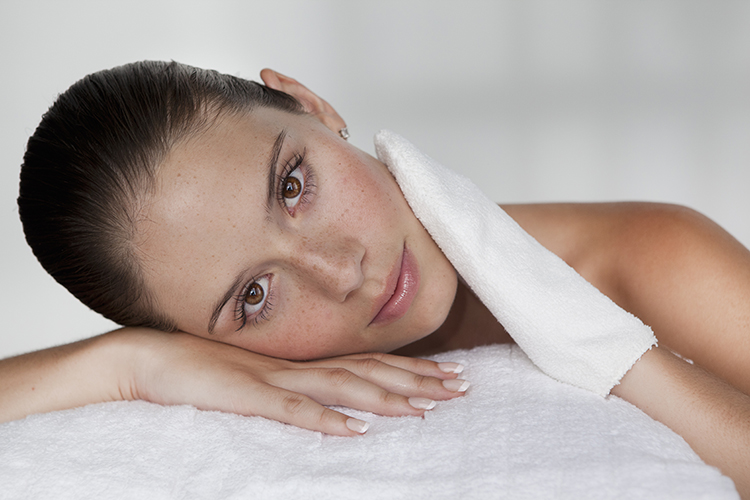AHAs, BHAs and acid-based exfoliants have quietly been generating buzz in expert circles for a long time.
Now, buoyed up with the guarantee of a more even, glowing complexion and fewer fine lines, they’re breaking through into the beauty mainstream.
To the uninitiated, the word ‘acid’ might seem a little intense, even scary, which is why we’ve broken down everything from the benefits to the need-to-know ingredients to the application mistakes you should avoid in this beginner’s guide…
What is a liquid exfoliant?
Also known as exfoliating toners, a liquid exfoliant uses chemicals like AHAs and BHAs to sweep away dead skin cells, leaving skin smoother and more radiant. Thanks to the active ingredients, they’re often far more effective than traditional scrubs. “A physical exfoliant will only ever remove the dead skin cells on the surface; a liquid will do exactly that but also work deeper into the skin, ungluing the bonds between cells,” explains facialist and skincare expert Abigail James.
What are AHAs and BHAs – and what’s the difference between them?
An AHA is an alpha-hydroxy acid. “These are usually derived from a natural or plant source, and are water soluble,” says James. “Simply put, AHAs are dead-skin blasters. If you picture your skin as a brick wall, AHAs work by loosening the cement in between the bricks (or cells) allowing them to fall away more easily, revealing brighter, healthier new walls beneath.” Beta-hydroxy acids (or BHAs) meanwhile, are oil soluble, meaning that they’re particularly effective for spot-prone complexions. ‘BHAs can travel into the pores for an extra deep clean-out,” says David Delport, Global Head of Education for REN Skincare.
Sometimes nicknamed fruit acids, lactic, citric and glycolic acid are among the AHAs most commonly used in skincare products. Salicylic acid, a mainstay of anti-breakout remedies, is probably the best-known BHA.
What are the skincare benefits?
Wondered why every skincare brand under the sun seems to be rushing to jump on the AHA/BHA bandwagon? It’s because, when used correctly, acid-based products have a whole host of complexion-boosting benefits. “They target uneven texture, sluggish skin turnover, congested pores, pigmentation and can even act as a booster to allow better absorption of our favourite serums and moisturisers,” says Delpole. That’s not to say that finding the right product is a case of ‘one size fits all.’
“Not all AHA and BHA liquid exfoliators are made equal,” Delpole stresses. “Sensitive skin types should gravitate towards enzymatic exfoliators, lactic acid and BHAs. Darker skin tones need to be sure that the product isn’t triggering redness due to incorrect pH, as this can cause a pigmentation response after inflammation.”
Is it possible to use both AHAs and BHAs?
Yes! “They have separate benefits,” explains Delport. “AHAs are more about sloughing dead skin cells, while BHAs are for pore cleaning, inflammation reduction and spot prevention. Some products, like Glossier’s newly launched Solution, are formulated with both.”
Which ingredients should I be looking out for?
Salicylic acid: “This is anti-bacterial and anti-inflammatory, although derived from aspirin – don’t use if you have an allergy to this,” explains James.
Glycolic acid: James describes the smallest alpha-hydroxy acid as “a bit old school but a good all-round exfoliant.”
Lactic acid: “This is our go-to because it’s a larger molecule than glycolic, meaning that while it takes a little longer to penetrate, the skin has a moment to adjust to the drop in pH,” says Delport. ‘Lactic acid has the ability to not only exfoliate but also hydrate.
Kojic acid: A by-product in the making of sake, this is “great for pigmentation,” according to James.
Mandelic acid: “Derived from bitter almond, this is good for acne and pigmentation,” she adds.
What’s the best way to introduce AHAs, BHAs and other acids in my skincare routine?
Start with a lactic acid: “Don’t get over-excited with the strongest offering,” says Delport. “The skin isn’t easily fooled – if you’re going red or your skin burns after an AHA product, then you’re triggering ageing inflammation.” If your skin is left flushed and red, scale it down to something lighter and work your way back up. The Ordinary’s Lactic Acid comes in 5% and 10% formulations, allowing your skin to adapt to a lighter acid before moving on to a higher concentration.
Do a patch test: Delport recommends testing out acid-based products on the neck first.
Start with just one application a week: This will give your skin time to get used to the pH change. Use your liquid exfoliator after cleansing in the evening.
Use SPF: SPF should already be a building block in your daily skincare routine, but it’s even more crucial when you’re using an acid-based exfoliator. While they can help fade pigmentation brought on by UV exposure, both AHAs and BHAs can also – ironically increase skin’s sensitivity to the sun’s rays.
How often should they be used?
Once your skin is used to acid-based products, two to three times a week should be enough, although “it all depends on the strength of the formula,” says Delport (some AHA products, like REN’s new Ready Steady Glow tonic, are light enough for daily use).
“I’d suggest a specific at-home peel once a week for normal skin,” adds James. “For problem skin, you might include BHAs daily.” It’s certainly worth starting small and slow, giving yourself time to fine-tune the ingredients which work well for your complexion (and to minimise any adverse reactions).
This article originally appeared on Grazia UK.











